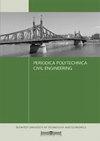用软计算和统计方法预测岩石抗拉强度
IF 1.4
4区 工程技术
Q3 ENGINEERING, CIVIL
引用次数: 0
摘要
岩石的抗拉强度是影响结构基础和地下空间破裂、岩质边坡稳定性和岩石钻爆能力的有效因素之一。本研究采用简单回归(SR)、多元线性回归(MVLR)、径向基核函数支持向量回归(SVR)、多层前馈人工神经网络(MFF-ANN)、平方指数核函数高斯过程回归(GPR)和基于高斯隶属函数的自适应神经模糊推理系统(ANFIS)等方法对抗拉强度进行估计。为此,对伊朗南部的石灰岩、砂岩和泥质石灰岩样品的岩石学和工程特征进行了评估。将本研究的结果与前人的研究结果进行比较,发现我们的研究结果与已发表的作品具有很强的相关性(R2=0.95 ~ 1.00)。为了估计巴西抗拉强度(BTS),将吸水率(重量)、点载荷指数(PLI)、孔隙率%、纵波速度(Vp)和密度等指标属性作为输入。方法采用各种标准进行比较。该方法对抗拉强度的SVR精度(R=0.96)高于MFF-ANN (R=0.92)、ANFIS (R=0.95)、GPR (R=0.945)和MVLR (R=0.89)。5种方法的实验室实测和预测的平均BTS分别为6.62和6.71 MPa,表明所研究方法具有很高的精度。利用统计分析对发展关系的模型准则进行分析,表明使用经验方程具有足够的精度。本文章由计算机程序翻译,如有差异,请以英文原文为准。
Prediction of Rock Tensile Strength Using Soft Computing and Statistical Methods
The tensile strength of the rocks is one of the effective factors in the rupture of structure foundations and underground spaces, the stability of rocky slopes, and the ability to drill and explode in rocks. This research was conducted to estimate tensile strength using methods such as simple regression (SR), multivariate linear regression (MVLR), support vector regression (SVR) with radial basis kernel function, multilayer feed-forward artificial neural network (MFF-ANN), Gaussian process regression (GPR) using squared exponential kernel (SEK) function, and adaptive neuro-fuzzy inference system (ANFIS) based on Gaussian membership function. For this purpose, petrography, and engineering features of the limestone, sandstone, and argillaceous limestone samples in the south of Iran, were assessed. The results obtained from this study were compared with those of previous research, revealing a strong correlation (R2=0.95 to 1.00) between our findings and the published works. To estimate Brazilian tensile strength (BTS), the index properties including water absorption by weight, point load index (PLI), porosity%, P-wave velocity (Vp), and density were considered as inputs. Methods were compared using various criteria. The SVR precision (R=0.96) was higher than MFF-ANN (R=0.92), ANFIS (R=0.95), GPR (R=0.945), and MVLR (R=0.89) to estimate the tensile strength. The average BTS measured in the laboratory and predicted by all 5 methods is 6.62 and 6.71 MPa, respectively, which shows the very high precision of the investigated methods. Analysis of model criteria using statistical analysis for developed relationships revealed that there is sufficient accuracy to use the empirical equations.
求助全文
通过发布文献求助,成功后即可免费获取论文全文。
去求助
来源期刊

Periodica Polytechnica-Civil Engineering
工程技术-工程:土木
CiteScore
3.40
自引率
16.70%
发文量
89
审稿时长
12 months
期刊介绍:
Periodica Polytechnica Civil Engineering is a peer reviewed scientific journal published by the Faculty of Civil Engineering of the Budapest University of Technology and Economics. It was founded in 1957. Publication frequency: quarterly.
Periodica Polytechnica Civil Engineering publishes both research and application oriented papers, in the area of civil engineering.
The main scope of the journal is to publish original research articles in the wide field of civil engineering, including geodesy and surveying, construction materials and engineering geology, photogrammetry and geoinformatics, geotechnics, structural engineering, architectural engineering, structural mechanics, highway and railway engineering, hydraulic and water resources engineering, sanitary and environmental engineering, engineering optimisation and history of civil engineering. The journal is abstracted by several international databases, see the main page.
 求助内容:
求助内容: 应助结果提醒方式:
应助结果提醒方式:


